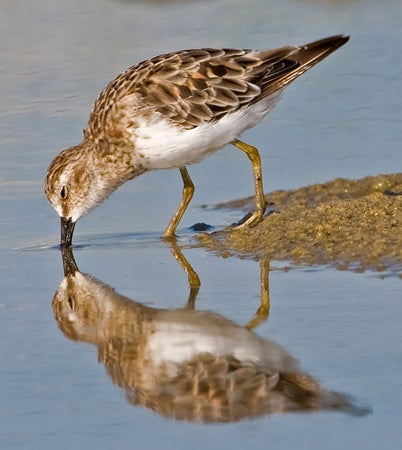SCIENTIFIC NAME:
Calidris minutilla
OTHER NAMES:
American Stint, little sandpiper, mud peep, ox-eye, peep, and peep, Wilson’s stint.
STATUS:
Fairly common in winter, common in spring and fall, occasional in early summer, and uncommon in late summer in Gulf Coast region. In other regions, common in spring, fairly common in fall, uncommon in winter and late summer, and occasional in early summer. Low Conservation Concern.
DESCRIPTION:
There are 82 species of sandpipers world wide with the least sandpiper being the smallest found in North America. The least sandpiper is a very small shorebird that measures five to six inches, weighs roughly 0.67 to 1.06 ounces and has a wingspan of about 11 inches. Sexes are similar in coloration with brown gray above and white underparts. Females are usually larger than males. The least sandpiper has a small black bill, about the length of its head, and dull yellow or yellow-green legs.
Adults have reddish and black spots on their back, two white lines going down their back, a brown-gray breast band and black line on the rump that extends to the tail. Juveniles have black based back feathers with a white “V” on the back. The breast is golden with fine streaking throughout and the crown is rust colored. Identification of sandpipers is difficult but juveniles usually have bright colored and crisp edges on feathers where as adults have dull and tattered edges on their feathers. Call notes include wheet, wheet, wheet or kreep.
DISTRIBUTION:
Breeds from Alaska to Canada. Winters across Oregon south (Pacific coast) and southeastern United States along coastal North Carolina and south (Atlantic coast) and the Gulf Coast through Mexico, Central America and Brazil.
HABITAT:
Least sandpipers are found along coast lines but frequent bay flats and muddy marshes of brackish ponds or creeks. In spring, they are primarily found on sandy ocean or bay beaches and occasionally on inland mud bars of beaches and rivers, and the shores of lakes, ponds and rain pools.
FEEDING HABITS:
Diet consists mostly of insects found in marshy areas. Insects include mosquitoes, grasshoppers and other aquatic invertebrates. Sandpipers will also probe for insect larvae or worms in mudflats and shallow waters. Along coastal areas, sandpipers have been observed to pick up small crustaceans like “beach fleas” and small mollusks.
LIFE HISTORY AND ECOLOGY:
The Least sandpiper arrives on the breeding grounds in May to June. Nesting occurs in a grass lined cup nest found in grasses or a moss hummock in open marshes. Four pinkish buff colored and blotched with dark brown eggs are laid. Eggs are mostly incubated by the male for 19-22 days. The female migrates south just after eggs hatch.
REFERENCES:
http://www.birds.cornell.edu/AllAboutBirds/BirdGuide/Least_Sandpiper.html
Field Guide to the Birds of North America. Page 40 1987. Second Addition. National Geographic Society, Washington, D.C., USA
Terres, J.T. 1980. The Audubon Society Encyclopedia of North American Birds. Pages 682-683. Alfred A. Knopf, New York, New York, USA.
AUTHOR:
Ericha Nix, Wildlife Biologist, Alabama Division of Wildlife and Freshwater Fisheries






